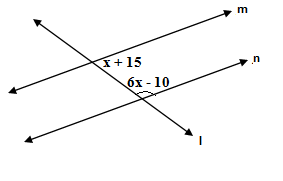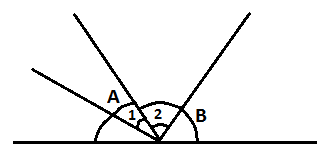9th Grade > Mathematics
LINES AND ANGLES MCQs
Lines And Angles
:
A
Extend OP. Then, a triangle PQT will be formed; where T is the point at which OP cuts QR.
Now,
∠OPQ + ∠QPT = 180∘
⇒∠QPT = 180∘ - 110∘ = 70∘
Now, since if OP || RS, ∠SRQ and ∠UTQ are corresponding angles hence, ∠UTQ = ∠SRQ = 130∘
Therefore we have,
∠UTQ + ∠PTQ = 180∘
⇒∠PTQ = 180∘ - 130∘ = 50∘
In triangle PTQ,
∠PTQ + ∠TQP + ∠QPT = 180∘
⇒50∘ + ∠TQP + 70∘ = 180∘
⇒∠TQP = 180∘ - 120∘ = 60∘
⇒∠TQP = ∠PQR = 60∘
:
A
The angle on a straight line is 180∘. Adjacent angles on a straight line add up to 180∘.
Conversely, if adjacent angles add up to 180∘ then the angles are on a straight line.
Hence, if x + y = 180∘ , then A, B and C lie on a straight line.
Therefore, both the statements are true and statement 2 is the correct explanation of statement 1.
:
B
Since, the sum of co-interior angles (interior angles on the same side) = 180∘
⇒x + 15∘ + 6x - 10∘ = 180∘
⇒7x + 5∘ = 180∘
⇒ 7x = 175∘
⇒x = 25∘
:
C
Let the two equal angles be x.
Then the third angle y = 2x
Also we know,
y + 2x = 180° (Sum of the angles of a triangle is 180°)
2x + 2x = 180°
4x = 180°
x = 45°
Hence the two equal angles are 45° each and the other angle is 90° which makes this triangle a right angled triangle.
:
C and D
The sum of the three angles of a triangle should be 180∘. Hence it cannot have two right angles. If it has all angles less than 60∘ then they cannot add up to form 180∘. A triangle can have two or three acute angles. It cannot have two obtuse angles because then the sum of the three angles would be greater than 180∘.
:
Given that,
2a - 3b = 60∘
Also if they form a linear pair, then
2 × (180∘ - b) - 3b = 60∘ ( since a = 180∘ - b)
⇒ 360∘ - 2b - 3b = 60∘
⇒ 5b =300∘
:
B
The sum of two complementary angles is 90∘.
If one angle is x, then another angle will be 90∘−x.
⇒x−(90∘−x)=14∘
⇒ 2x=104∘
⇒ x=52∘
:
A
The sum of all the three angles of a triangle = 180∘
Since the angles are in the ratio 2 : 4 : 3, let x be a factor such that,
2x + 4x + 3x=180∘
=> 9x = 180∘
=> x = 20∘
Hence the three angles of the triangle are:
=> 2x = 40∘
=> 4x = 80∘
=> 3x = 60∘
So the smallest angle in the given triangle is 40∘.




















